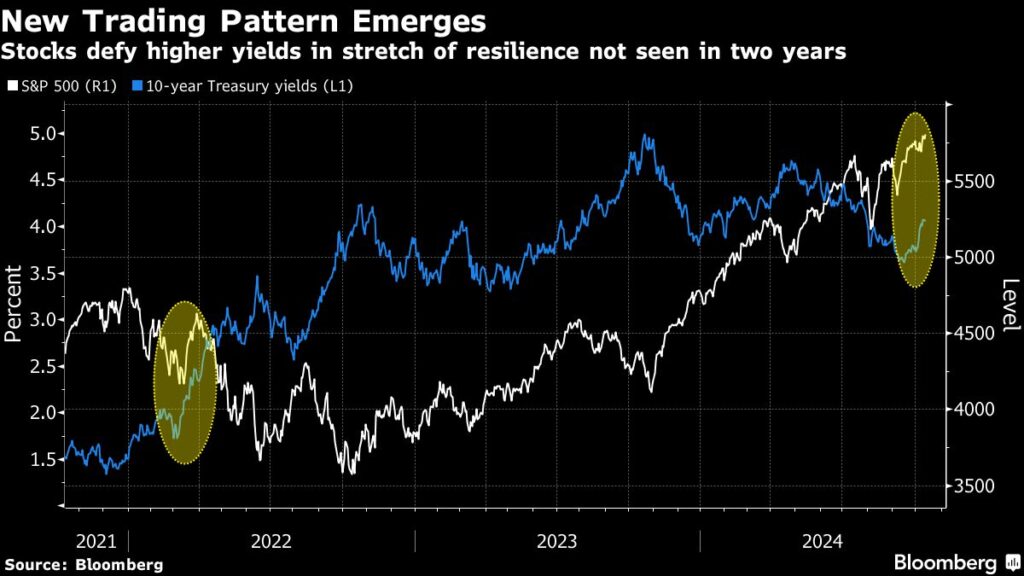(Bloomberg) — Take a snapshot of markets right now, and it’s a picture of health. Stocks are at records, corporate bonds show no signs of worry and commodities remain buoyant on global economic optimism.
Most Read from Bloomberg
Drill down though, and the outlook quickly turns murky. Alongside all the outward cheer, volatility is an equally big story in almost every asset class. Traders, who got blindsided when things turned violently against them in August and September, are piling into hedges — pushing the cost of protection up almost as fast as markets themselves.
The rush is creating unusual contours across assets. In one example, volatility indexes in equities and Treasuries just capped two of their bigger weekly advances of the year. The runups left both fear gauges at their highest in more than two decades — when plotted against other periods when the S&P 500 sat at a record.
All in, sentiment remains febrile among key constituencies on Wall Street, thanks to next month’s US election, the uncertain Federal Reserve policy trajectory and recent market traumas.
“The odds that a low-probability, very bad event will happen are higher,” said Amy Wu Silverman, head of derivatives strategy at RBC Capital Markets. “Post the August VIX spike markets have normalized and made new highs. Yet, the underlying ‘worry’ had remained elevated.”
While asset prices frequently rise at times of investor anxiety, the situation now is especially extreme, with bullishness and skepticism both evident in equal parts. The S&P 500 has risen for five straight weeks and in eight of the last nine, closing Friday at its 45th record of the year after earnings from JPMorgan Chase & Co. and Wells Fargo & Co. topped estimates. US investment-grade bond spreads are the narrowest in more than three years.
At the same time, with market plunges of early August and September fresh in traders’ minds, gauges of investor nervousness are flashing readings of caution that are rare during bullish regimes.
Both the Cboe Volatility Index in equities and the ICE BofA MOVE Index in Treasuries have risen sharply since the start of the month. A global measure of cross-asset risk kept by Bank of America Corp. has hit the second-highest level of the year — eclipsed by only the early August selloff, which erased trillions of dollars from global share values in a matter of days. The indicator tracks stress across global equities, rates, currencies and commodities and measures future price swings implied by options.
In other words, while calm prevails in the here and now, past shocks and uncertain prospects for the future are weighing heavily on sentiment.
Traders shell-shocked by summer chaos are coping with a deadlocked presidential race, war in the Middle East and a still-expanding economy that continues to fuel doubts, like this week’s data on jobless claims.
At the same time, there’s a growing sense Jerome Powell’s Fed may be less inclined to immediately add fresh juice to the economy. Data Thursday showing higher-than-expected consumer inflation and last week’s blowout US jobs report have caused traders to unwind bets on the size of the 2024 interest-rate cuts. Atlanta Fed President Raphael Bostic, for his part, said he’d be open to skipping another rate reduction next month.
“There is almost a sense of distrust in the market,” said Peter Tchir, head of macro strategies at Academy Securities. “There are some large moves have occurred overnight. Lots of concerns and yet stocks generally drifting higher. We have had several rapid moves to the downside.”
There are also signs short positions are rebuilding in bonds and stocks after investors rode a synchronized rally for five straight months. Bearish wagers against the SPDR S&P 500 ETF Trust have reached 2.4% of its outstanding shares, up from a four-year low of 1.6% at the start of the month, according to IHS Markit data. Similarly, iShares 20+ Year Treasury Bond ETF’s short ratio hit a 15-month low in August but has now risen above 1%.
The options market shows that demand for protection for a big stock crash is brisk, with tail-risk hedging measures hitting levels rarely seen in the past two years. The MOVE Index, which tracks bond volatility, surged to its highest since January, while a similar measure for crude oil spiked to a level not seen in two years. The iShares iBoxx $ Investment Grade Corporate Bond ETF has seen its implied volatility rising relative to the realized price swings since August, in the latest sign traders are paying up for insurance against losses.
Still, the S&P 500 is up roughly 3% in the face of an increase of more than 40 basis points in 10-year Treasury yields over the past month — a feat of resilience not seen since April 2022.
“The market has been very strong despite several macro and micro risks,” said Erika Maschmeyer, portfolio manager at Columbia Threadneedle Investments. “We would not be surprised to see a pullback as we approach the peak election period and next rate decision.”
Earnings season is the next test for a market where the S&P 500’s price-earnings ratio has risen to the highest level since 2021. While third-quarter profits are forecast to expand 4%, the slowest rate in a year, investors will focus on whether corporate income can rebound in the coming months. Analysts expect growth to accelerate to 14% next year, data compiled by Bloomberg Intelligence show.
“Investors are expressing extreme optimism. Valuations are very rich,” said Michael O’Rourke, chief market strategist at JonesTrading. “The FOMC’s aggressive easing stance despite robust economic data has fueled investor overconfidence.”
Most Read from Bloomberg Businessweek
©2024 Bloomberg L.P.
Read the full article here

